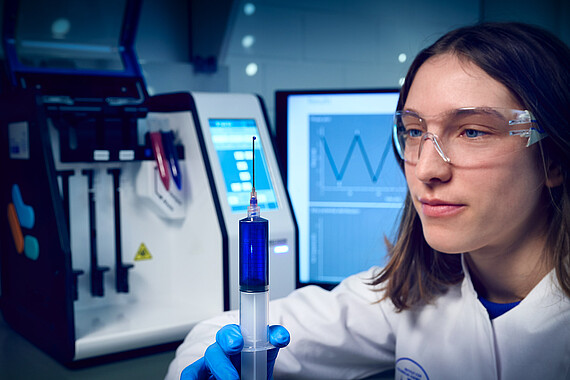

 ©
Harry Köster/ harry-koester.de
©
Harry Köster/ harry-koester.de
Chip technologies
Since the turn of the millennium, high-throughput technologies have been available to biological research that enable to detect the various cellular biomolecule species in their entirety – such as genes, proteins, metabolic products, etc. These high-throughput technologies are technically referred to by the term “omics” technologies and are primarily based on so-called microarrays, with which several thousands of individual determinations can be carried out in parallel; only very small sample amounts are required. These microarrays are also called bio-chips because, like a computer chip, they can store a large amount of information in a very small space. Microar-rays consist of modified glass surfaces on which high spot densities (up to 120,000) with very small spot diame-ters (less than 250 µm) can be applied.
Biotesting
Analytical tests for the evaluation of substances, such as active ingredients or nanoparticles, are developed in the Stahl Study Group. These substances can be present and tested in different chemical compositions and geometries; the tests can also be carried out specifically in accordance with REACH specifications. Toxicity tests are carried out two- and three-dimensionally in parallelizable, cellular test systems, which allow rapid toxicity screening. In addition, examinations of inflammation and infection – e.g., at the cytokine level – can be per-formed. Moreover, research will be carried out in the future to replace animal experiments with so-called cell or organ arrays to close the gap between in-vitro and in-vivo test systems. Ultimately, quantum dot and metal oxide nanoparticles are synthesized in-house, and tested for therapeutic applications. We also develop so-called nanotheranostics.
Chip Technologies


 ©
Harry Köster/ harry-koester.de
©
Harry Köster/ harry-koester.de
A complete chip system consisting of Affymetrix 427 Arrayer, Gesim Nanoplotter 2.1, Axon 4000B Arrayscanner, Theonyx pipetting robot, and an Agilent bioanalyzer is available at the institute, and the work has been fully established up to routine use in research and diagnostics, including data analysis. The following array formats can be offered: DNA arrays, protein arrays, aptamer arrays, target arrays, tissue arrays, living cell arrays and the lab-on-a-chip analysis of biomolecules. In addition to classical gene-expression analyzes, functional applications are increasingly being developed and carried out, which extend into the areas of biosensors, active ingredient screening, and biotesting; they also include a variety of interactions with the Rebirth and NIFE clusters of excel-lence as well as the new BMWZ. As part of a BMWZ cooperation, a real, direct “target omics” process has now been established for the first time. When developing the method, heat shock proteins (Hsps) were initially used as targets. To this end, the chip system available at the Institute for Technical Chemistry was used to print the Hsp90 protein as a ‘catcher’ on nitrocellulose chip surfaces. If such a ‘capture molecule’ binds a marker provid-ed with a dye (usually a molecule from the cellular environment), an optical binding signal can be measured. Subsequently, the competitive binding of other substances (in the present case the new derivatives of Gel-danamycin) to Hsp90 is investigated using a so-called displacement assay. Possible drug candidates can not only displace the marker, but – as an active intracellular ingredient – they may also reduce the folding activity of the Hsp90 and thus cause tumor cells to undergo apoptosis. The developed procedure enables the testing of chem-ical compound libraries in a high-throughput procedure against defined disease-specific targets.
Biotesting


 ©
Harry Köster/ harry-koester.de
©
Harry Köster/ harry-koester.de
The Stahl Study Group has set up stringent cellular test systems that can be used in two- and three-dimensional manner, as well as statically and dynamically, to test materials and active ingredients with regard to (i) their toxicity, (ii) their biocompatibility and (iii) their potential effects on the test cells’ growth and differentiation behavior. The test systems employed record phenotypic and functional cell characteristics as well as the representation of molecular markers. The complementarity of the methods allows for a valid, efficient, and standardizable monitoring of the culture conditions – and, thus, the iterative optimization of the tested materials/substances. Particular emphasis is placed on the miniaturization of the test systems into so-called ‘living cell microarrays’, and on developments to replace animal experiments by cellular and organ arrays. All test systems can be operated with cell lines, primary cells, and stem cells and are designed to be cryopreservable. These cell chips may also be employed in the controllable diagnostics of, for example, tumor cells. Here, the cell-specific binding of nanotools should primarily be used to monitor or induce a therapeutic effect.
Statistical Evaluation
Microarray technology can significantly accelerate the speed of expression analyses. However, their complexity and variability must be taken into account in the evaluation so as to obtain significant high-quality data. This is where bioinformatics comes into play. A user-friendly microarray analysis program was developed at the Institute for Technical Chemistry, which is able to solve one of the greatest difficulties in handling microarray data by integrating a promising multi-scan approach. In order to warrant correct measurements of the sample values, which can span a wide range of intensities, an algorithm was implemented that includes a linear regression. This approach combines linear areas of multiple scans that were recorded with different scanner sensitivities. Publicly available databases – e.g., Gene Expression Omnibus (GEO) – can be accessed for the further processing and interpretation of the evaluated and classified data records.
Contact


30167 Hannover




